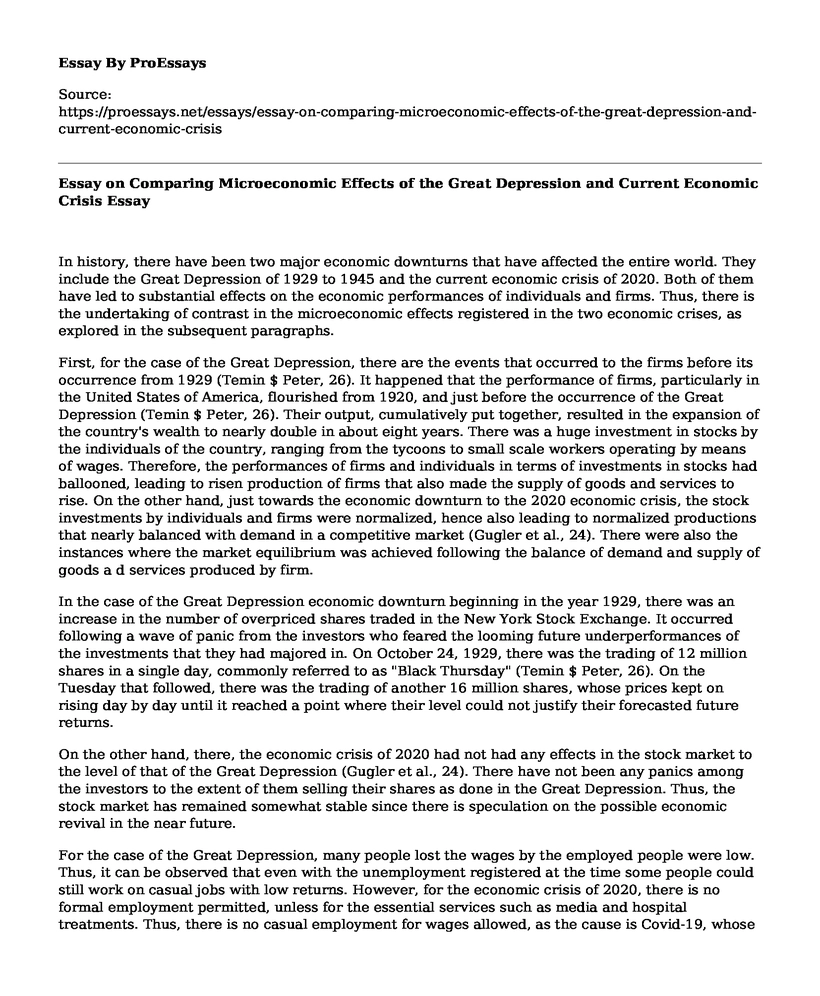In history, there have been two major economic downturns that have affected the entire world. They include the Great Depression of 1929 to 1945 and the current economic crisis of 2020. Both of them have led to substantial effects on the economic performances of individuals and firms. Thus, there is the undertaking of contrast in the microeconomic effects registered in the two economic crises, as explored in the subsequent paragraphs.
First, for the case of the Great Depression, there are the events that occurred to the firms before its occurrence from 1929 (Temin $ Peter, 26). It happened that the performance of firms, particularly in the United States of America, flourished from 1920, and just before the occurrence of the Great Depression (Temin $ Peter, 26). Their output, cumulatively put together, resulted in the expansion of the country's wealth to nearly double in about eight years. There was a huge investment in stocks by the individuals of the country, ranging from the tycoons to small scale workers operating by means of wages. Therefore, the performances of firms and individuals in terms of investments in stocks had ballooned, leading to risen production of firms that also made the supply of goods and services to rise. On the other hand, just towards the economic downturn to the 2020 economic crisis, the stock investments by individuals and firms were normalized, hence also leading to normalized productions that nearly balanced with demand in a competitive market (Gugler et al., 24). There were also the instances where the market equilibrium was achieved following the balance of demand and supply of goods a d services produced by firm.
In the case of the Great Depression economic downturn beginning in the year 1929, there was an increase in the number of overpriced shares traded in the New York Stock Exchange. It occurred following a wave of panic from the investors who feared the looming future underperformances of the investments that they had majored in. On October 24, 1929, there was the trading of 12 million shares in a single day, commonly referred to as "Black Thursday" (Temin $ Peter, 26). On the Tuesday that followed, there was the trading of another 16 million shares, whose prices kept on rising day by day until it reached a point where their level could not justify their forecasted future returns.
On the other hand, there, the economic crisis of 2020 had not had any effects in the stock market to the level of that of the Great Depression (Gugler et al., 24). There have not been any panics among the investors to the extent of them selling their shares as done in the Great Depression. Thus, the stock market has remained somewhat stable since there is speculation on the possible economic revival in the near future.
For the case of the Great Depression, many people lost the wages by the employed people were low. Thus, it can be observed that even with the unemployment registered at the time some people could still work on casual jobs with low returns. However, for the economic crisis of 2020, there is no formal employment permitted, unless for the essential services such as media and hospital treatments. Thus, there is no casual employment for wages allowed, as the cause is Covid-19, whose preventive measure is the observation of social distancing by the people (Gugler et al., 24). Thus, the firms are hardly in operation as hardly few people are allowed to work, with a small percentage of them working from home. The reduced production of goods coupled with their increased prices, alongside the insufficiency of money in the hands of people, has threatened the economy of firms and individuals.
Works Cited
Gugler, Klaus, Michael Weichselbaumer, and Christine Zulehner. "Employment behavior and the economic crisis: Evidence from winners and runners-up in procurement auctions." Journal of Public Economics 182 (2020): 104112. https://www.tandfonline.com/doi/abs/10.1080/14616696.2019.1636110?casa_token=KCKx2xTBY0IAAAAA:_tc8_YCA-IQvq9NUo79wzqHoeq24DYn6QzukX6m0YaePkcjboJHXxzC7pD9C9pJhiz2oQDPmvcPGn1Hq
Temin, Peter. "Great Depression." Banking Crises. Palgrave Macmillan, London, 2016. 144-153. https://link.springer.com/chapter/10.1057/9781137553799_16
Cite this page
Essay on Comparing Microeconomic Effects of the Great Depression and Current Economic Crisis. (2023, May 29). Retrieved from https://proessays.net/essays/essay-on-comparing-microeconomic-effects-of-the-great-depression-and-current-economic-crisis
If you are the original author of this essay and no longer wish to have it published on the ProEssays website, please click below to request its removal:
- The Assassination of Franz Ferdinand in 1914 Essay Example
- Biographical Essay on Lenore Tawney
- Essay Example on Benito Mussolini: Fascist Rule and World Politics
- Essay Sample on Controversial War Powers: US Executive & Legislative Branches
- Essay Sample on Fixed Exchange Rates: Advantages & Disadvantages
- Essay Example on Elvira's Story: An Immigrant's Journey for a Better Life
- Civil War Diseases - Essay Sample







